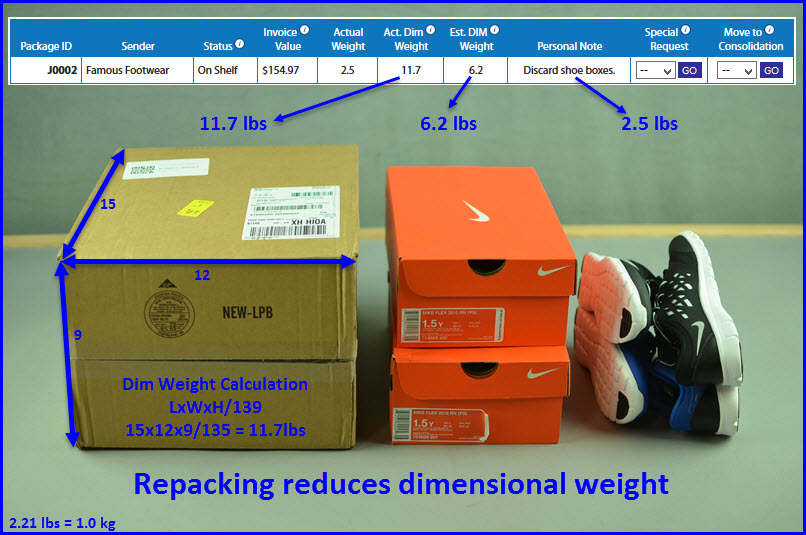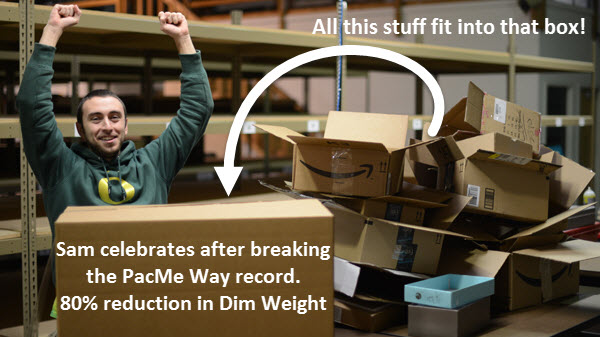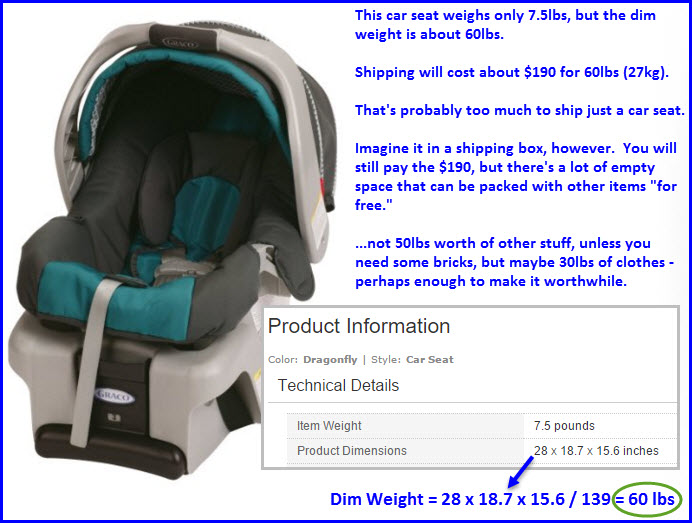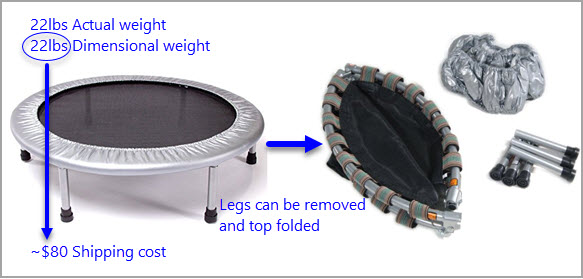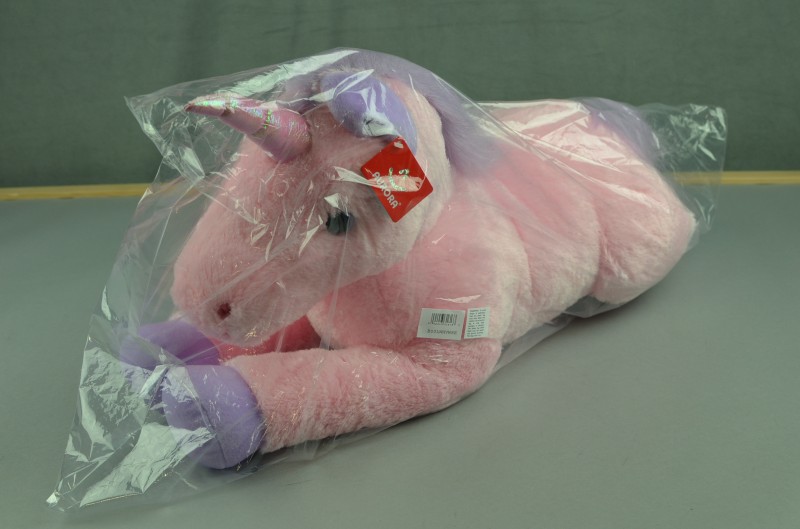Search |
Dim Weight
The shipping carriers need to consider the actual weight of a package but also the space it occupies on the plane, so they came up with the concept of "dimensional" weight. The "billable" weight is then the higher of the two weights.
The formula is quite simple:
For instance, a 40cm cube box has a fixed dim weight of about 13kg. If you fill the box with 7kg of stuff, you would still pay the 13kg rate, even if the box is only "half full." Generally speaking, if there is empty space in your box, you are still paying to ship it.
You can read the rest of the dim weight FAQ to see how PacMe's repacking expertise reduces the dim weight. Or check our the PacMe Way proof.
In the video below, we demonstrate different ways to pack a box and reduce the billable weight by more than half.
On the website, we will show you the dimensional weight of the incoming package, as well as the estimated dim weight of what's actually inside. When we do the final repacking job, we can often reduce it further. Discarding shoe boxes is an obvious example...
The Dim/Actual ratio is the Dimensional Weight divided by the Actual Weight. Ideally, we want this number to be less than 1.00. That means you won't be paying the dim weight surcharge. You will ultimately see the ratio three different times. It let's you know how your shipment will be, or was, affected by dim weight.
In the screen shot below, a real example, the customer's 16 individual packages weighed a total of 23lbs (1st column). The sum total of their actual dimensional weights was 64lbs (2nd column). That's almost 3 times as much. Ouch. Even before repacking the PacMe Way, however, we estimated we could get the dim weight down to 35lbs (3rd column). As it turned out, that is what happened in this example. We couldn't quite remove all the dim weight because some of the hats and fancy shoes needed to stay in their boxes.
How does PacMe estimate the dim weight before actually packing the final box? We first measure each incoming box to get the actual dim weight, and then we "haircut" this number by how much space we think we can save. Either the incoming box was only X% full, or we know that certain items dim-out at a particular ratio. Clothing for instance, is usually 1:1 for actual:dim weight. The more packages you have, the closer our estimate should be since we can fit, tetris-like, all your items into and around each other.
What if my dim weight looks bad? If you see that dim weight might be an issue, send us a chat. We will take a closer look at all your items and update our estimates. The original estimates were made one incoming package at a time in a vacuum.
What can I do about it? Dim Weight isn't necessarily bad. If you want that hat, then you want that hat. We only think it is bad since we are used to paying for the actual weight, not some weight based on an arbitrary formula.
Think of the extreme example of buying a suitcase, which is a common purchase of our customers. A suitcase definitely triggers dim weight. You will pay for the dimensional weight, not the actual weight. You can fill up the suitcase essentially for free since you are already paying for the dim weight. Likewise, if you need to buy hollow or awkward-shaped items, then they will need to be shipped in a big box. Buy lots of smaller items so we can fill all the nooks and crannies. They essentially ship for free until the actual weight equals the dim weight.
Conversely, let's say you need to ship a bunch of heavy poker chips or metal tools. Now, you can ship them in a larger box - a box that would have the dimensional weight equal to the actual weight of the chips or tools. That box will have a lot of empty space that you can fill up for free.
We consolidate items, not boxes. And then we take that a step further by really packing the PacMe way, like in the photos below...
Here's the summary of how we reduce dim weight. Dimensional Weight is caused by four issues:
Now for the long story...
The dim weight of a box is fixed according to the formula L x H x W / 5,000 (for cm and kg). For instance, a cube box with sides of 50cm has a dim weight of 25kg. That will not change. The bummer is if you only have 15kg of items in the box, you'll still be charged for 25kg since the carriers charge the higher of the dim weight vs the actual weight. So, how does PacMe help reduce the dim weight?
Summary
Dim Weight is usually bad. If an item is of a large size relative to its weight (i.e. low density) and has no empty space in which to pack other items, then this type of dim weight cannot be mitigated. That's why we call it bad. A painting, pillow, comforter, fluffy pink unicorn, or plastic toy fire engine might weigh a kilogram or less, but because they are large, they will be charged at a much higher dimensional shipping weight, often 3-4x more. That seems bad, especially if you find out the hard way, like after buying all your kids' Christmas presents.
It's only bad if it is surprising, however. Once you know the cost-to-ship, whether based on actual or dim weight, then you can determine whether or not it is a good value.
It seems bad because we are used to thinking that we should pay for shipping based on the actual weight of something, not some formula concocted by the carriers. By the way, Dim Weight = LxWxH/139 for inches and pounds. Why 139? Just because. That's why it is surprising. Surprises are almost always bad.
It's not dim weight that is a bad value. It's a bad value that is a bad value.
It's not really bad because those soft and plastic toys are big and trigger dim weight. Those items are bad because they cost $10 to buy in the store and $60 to ship. That's $70 for a unicorn. Ok, maybe a unicorn costs $100 in your country so you are still ahead.
Replace the unicorn or plastic toy with a fancy $900 Stetson 00X El Presidente Fur Felt Cowboy Hat. That too weighs next to nothing and must be shipped in a big, dim-weight unhappy box. But Shipping a $900 item for $60 doesn't seem that bad.
Dim weight can be good in two different ways.
Suitcase dim weight is awesome. Here is what filling up a suitcase looks like in your account. This suitcase has an actual dimensional weight of 36lbs (16kg), based on the size of the suitcase in its shipping box. If we shipped it by itself, it would be charged at the 36lb rate even though it only weighs 10.7lbs (5kg). That would make both of us cry.
This customer was smart, however, and bought a lot of other items to fill up the suitcase, thereby offsetting the effect of its dim weight on the final shipment. We therefore reduced the "estimated dim weight" contribution to the final shipment from the original 36lbs down to 13lbs.
It's important to keep an eye on the totals at the bottom of the three different weight columns. Ideally we want to get the dim weight down to the actual weight (56lbs in the example below). We make an estimate of whether or not we think we can do that as the packages trickle in. The more you buy, the more likely our estimate will be correct because then we can Tetris them all together as we do the repacking.
BTW, simply removing the incoming items from their orginal boxes was expected to reduce the dim weight by 30% in this example (from 111lbs to 78lbs). Filling up the suitcase reduce it another 20% (from 78lbs to 55lbs). On average, we reduce dim weight by about 50%, so this is typical, though granted, an empty suitcase really helped out in this case. That cuts the shipping charge in half.
How much does it cost to ship a car seat (or somewhat similarly, a BBQ)? That is one of the few, truly "frequently asked questions" in the FAQ.
The answer is somewhere between $0 and $190. How can that be? It depends upon what else you "need" to ship at the same time.
Shipping a car seat by itself costs $190 (to Singapore). Let's say the car seat (photo below) has an "actual weight" of 7.5lbs (3.4kg). The dim weight is calculated by multiplying the dimensions of the box and dividing by 139 for inches and pounds: 28 x 18.7 x 15.6 / 139 = 60lbs (27kg).
You have to pay for the higher of the two weights. Shipping 60lbs to Asia or Europe costs about $190 (shipping calculator). That is if you ship it by itself. Bad news.
If you have learned anything from PacMe, it rarely makes sense to ship something by itself. Car seats are somewhere in between "bad" dim weight (plastic toys and mattresses) and "good" dim weight (empty suitcases). Usually there is enough space in the car seat's shipping box to add more things. Those more things essentially ship for free. That is, you are already paying for the dim weight, so you can keep on adding more actual weight until it reaches the dim weight.
Realistically, you can probably fit another 30lbs of clothes in the box. Those clothes would ship for "free." It still costs $190 to ship the box, true, but you are shipping a lot more stuff than just the car seat so it is a better deal overall.
How about $65? Looking at it another way... The total shipping cost is $190. That won't change. Shipping 30lbs of clothes by themselves would cost about $125. Do it with the car seat. Now, the car seat's share of the total cost is only 190 - 125 = $65 to ship. How's that for rationalization?
And yet another way... Let's say you are shipping 30lbs of clothes for $125. You really really need to buy those clothes. Then you think, ah, what if I want to add a car seat? Now the total will be $190. The clothes cost $125 and the car seat $65. Same good deal but in reverse.
How about $0? Let's keep going, how about shipping a car seat for free... Let's say you really really need to ship 60lbs of gym weights. You'd be surprised - it's still cheaper than buying them in many countries, even with shipping. Anyway, stick with me. You'll being paying for 60lbs because that is what your gym weights weigh.
The gym weights are flat so hardly take up any space. They would normally be shipped in a pretty small box. But instead, let's ship them in a huge box. As long as the dim weight of the box is 60lbs or less, then you aren't paying anything extra. We have a lot of empty room in the box now - enough to put in the car seat for free! Gym weights, or any heavy/super dense material, are called "dim weight busters." They afford you a lot of "free" dim weight.
So there you have it. Shipped by itself, the car seat costs $190. Shipped with clothes, you could argue it's $65, and shipped with gym weights, $0. Of course, this depends on your perspective and how you mentally allocate the shipping cost.
The point is: Go Big and then let PacMe do the repacking magic.
Mini trampoline rebounders appear to be a popular item, so we get the question, "How much does it cost to send a rebounder?" all the time. This item proves to be a pretty good example to discuss all the shipping issues associated with unusual items. They usually cost about $160 to ship.
A typical 40-inch diameter rebounder weighs 20-30lbs "actual" weight (i.e. place it on the scale and read the weight). This doesn't really matter, however.
The dimensional weight of the likely shipping box is about twice that: 41 x 41 x 4 inches / 139 = 48lbs dim weight.
The size of the shipping box is usually not listed in the item description. The length and width are easier to estimate - an inch wider than the diameter. The height of the box is a bit trickier and very important. If the the legs are the screw/snap-on type, then the height of the box is about 4 inches. If the legs are permament, on the other hand, say 8 inches, then the dimensional weight doubles!
Is there anything we can do about the dim weight?
Items that themselves are low-density will trigger dim weight and there is nothing we can do about it (think foam pillow). Items with "empty space" inside also trigger dim weight, but we can pack the inside "for free" (think suitcase). That is, you have to pay for the dim weight anyway, so we can stuff it until the actual weight catches up to the dim weight.
The same is true for a shipping box that necessarily needs to be larger than the item itself. You will pay for the dim weight of the box, but we can stuff it full of stuff effectively for free.
A rebounder is somewhere inbetween. The hollow legs and bands make it low density, but the box usually has a little extra room in it for clothes and flat items. That will mitigate the dim weight somewhat. The rebounder with permanent legs will have a lot of empty space, but we have to be careful about loading up the box because the security of the rebounder could be compromised.
Lastly, dim weight isn't necessarily bad. Bad value is bad. Some rebounders only cost $50. Then they cost $150 to ship. That's probably a bad value since you can probably find a cheap rebounder in your country for less. The pro rebounders cost $400 in the US. Most high-end stores in your country will then mark them up nearly double. So, the same $150 shipping expenses is not bad at all, relatively speaking.
Note how some rebounders will fold. This makes the shipping box slightly less volumnous and dim weight usually isn't triggered.
There's good dim weight and there's bad dim weight. A fluffy pink unicorn might be cute but it's pretty bad.
It weighs next to nothing, maybe 0.5kg, so you wouldn’t think it would cost much to ship. In fact, Amazon will probably ship it to our warehouse for free. It comes in a 30cm square box. Not small, but not that big either.
The problem is that it can't be squeezed down very far so will be charged at its "dimensional" weight, not actual weight.
Dimensional weight = Length x Width x Height / 5000 (for cm and kg) or LxWxH/139 (for inches and pounds).
So, this 0.5kg soft toy, if shipped overseas in a 30cm square box, would “weigh” 30x30x30/5000 = 5.4kg. That’s ten times more than probably expected!
Dim weight isn't necessarily bad. It's usually just suprising. Once you know how much something will really cost to ship, then you can determine if the value is still there.
Finally, our first fluffy pink unicorn...
|





